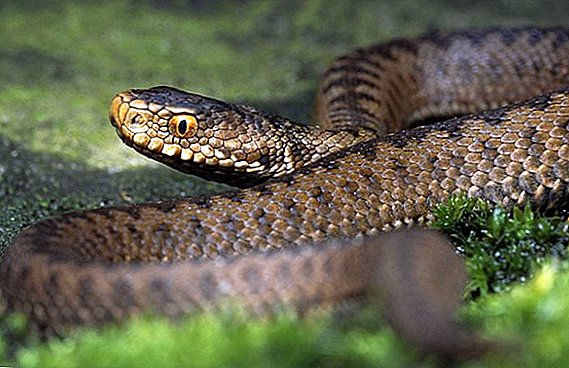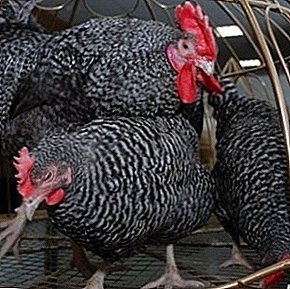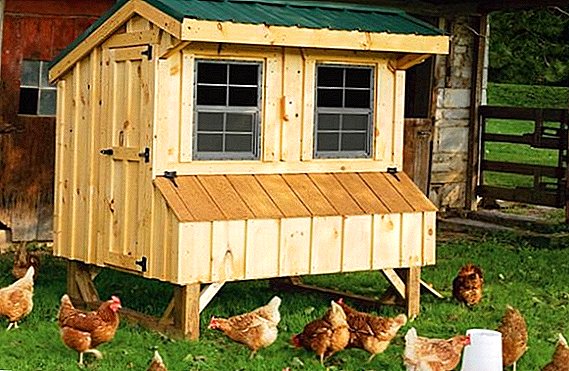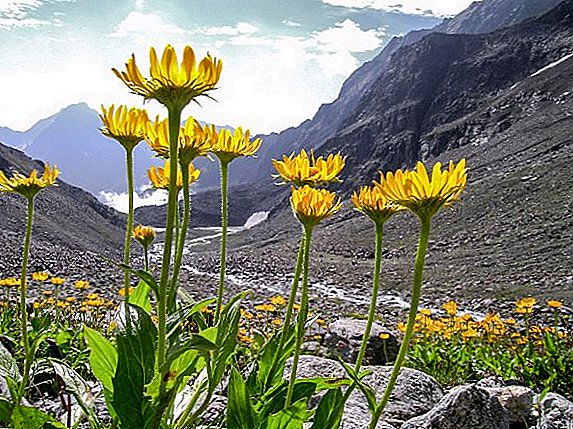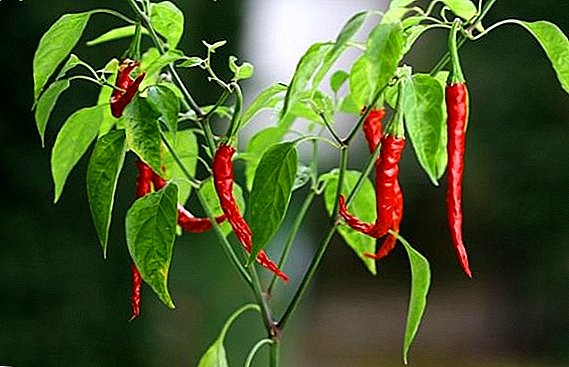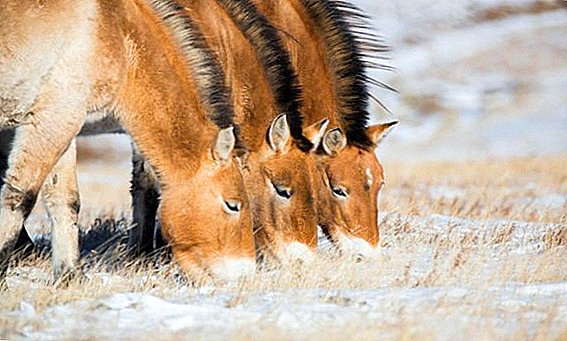 Often we hear that another species of animals has disappeared without a trace. This happens because of human intervention in natural habitats, as well as due to large-scale destruction by poachers. In addition, representatives of exotic species are popular in the black animal market. But our story with a good ending - a hundred years ago, the Przhevalsky horse was on the verge of extinction, and today this species is gradually increasing its population and the forecast for its revival is quite favorable.
Often we hear that another species of animals has disappeared without a trace. This happens because of human intervention in natural habitats, as well as due to large-scale destruction by poachers. In addition, representatives of exotic species are popular in the black animal market. But our story with a good ending - a hundred years ago, the Przhevalsky horse was on the verge of extinction, and today this species is gradually increasing its population and the forecast for its revival is quite favorable.
Discovery history
 This type of horse was discovered by a Russian explorer. Nikolai Przhevalsky in 1878, during his journey through the Kazakh steppes to the unconquered peaks of Tibet. Being on the border with China, the scientist received as a gift from his friend the remains of a horse, which he immediately forwarded to St. Petersburg for research at the Zoological Museum. His guess was confirmed: zoologists discovered that the skin and skull of an animal belong to a species of wild horses, which was not previously known to science. Later they were named after the discoverer.
This type of horse was discovered by a Russian explorer. Nikolai Przhevalsky in 1878, during his journey through the Kazakh steppes to the unconquered peaks of Tibet. Being on the border with China, the scientist received as a gift from his friend the remains of a horse, which he immediately forwarded to St. Petersburg for research at the Zoological Museum. His guess was confirmed: zoologists discovered that the skin and skull of an animal belong to a species of wild horses, which was not previously known to science. Later they were named after the discoverer.
Did you know? In the late 1990s, several dozen representatives of Przhevalsky's horses were brought to abandoned areas in the vicinity of the Chernobyl nuclear power plant. Apparently, the distance from the man and the pristine fields of fresh grass came to their liking - after a couple of years, the number of horses increased to hundreds of heads.
About Przewalski's horse: description
The Przewalski horse has a strong, squat croup with a developed musculature. The head is large, with small eyes and moving ears of a pointed form. The thick neck smoothly passes into a wide chest, legs short and strong. Height at withers rarely exceeds one and a half meters, body length - 2 meters. The coat is light brown, sandy colored, and a dark stripe runs along the back.  The tail and mane are always dark in color, the legs are also dark, sometimes light stripes may appear on them. This color allows horses to perfectly mask themselves among tall grasses and shrubs of the steppe zone. The mane is short, without bangs; the tail is long, but begins to fluff closer to the middle. A large head, a short mane and an unusual tail suggest that the Przhevalsky horse has wild asses among its ancestors, but it is not.
The tail and mane are always dark in color, the legs are also dark, sometimes light stripes may appear on them. This color allows horses to perfectly mask themselves among tall grasses and shrubs of the steppe zone. The mane is short, without bangs; the tail is long, but begins to fluff closer to the middle. A large head, a short mane and an unusual tail suggest that the Przhevalsky horse has wild asses among its ancestors, but it is not.
It is interesting to get acquainted with the horse breeds: Trakenen, Karachai, Shire, Orlov trotter, Friesian, Appaloosa, Tinker, as well as the pony subspecies and the mini-horse Falabella.
Przhevalsky's horses lead a social life - they are united in families consisting of a stallion, 3-5 mares and their foals. The stallion vigilantly watches all members of the family, and also looks out for predators on the way of his herd. These animals are well developed scent, hearing and vision, which helps them to sense the danger in advance. In search of new pastures and safe places for watering, the herd travels tens of kilometers daily, making short-term stops for eating and relaxing. At this time, the stallion vigilantly watches all members of his family, in case of danger, to repel predators.  In the spring, mating games begin at the horses. A female’s pregnancy lasts 11–12 months - a foal is always born to a mare, which she feeds with her milk for up to 1 year. The puberty period in males comes in 4-5 years, and in females - in 3-4 years. After reaching mature age, the young foal is driven out of the herd and, together with other males, forms a new herd, which begins to independently wander in the steppe.
In the spring, mating games begin at the horses. A female’s pregnancy lasts 11–12 months - a foal is always born to a mare, which she feeds with her milk for up to 1 year. The puberty period in males comes in 4-5 years, and in females - in 3-4 years. After reaching mature age, the young foal is driven out of the herd and, together with other males, forms a new herd, which begins to independently wander in the steppe.
Curious behavior of mares in case of danger - the females are in a circle in which the young are placed. No predator will break through such a barrier.
Important! Attempts to cross descendants of wild horses with hybrids of various breeds always ended with the appearance of barren offspring. Only crossing with a domestic horse yielded fertile descendants.
Przewalski's horse: dwelling
Przewalski's horse has a very limited habitat. In the wild, wild horses could be found in the steppes and semi-deserts of Kazakhstan, Mongolia, Western and Southern Siberia, Kashgar and Dzungaria. In addition to these territories, their small herds were found on the shores of Lake Zaisyan and in Transbaikalia. 
In nature
The last time they were spotted in the wild was in 1969. Hiding from a man and roaming in search of new pastures, the Przhevalsky horses made a tremendous journey until they reached the territory of Dzhungar Gobi and East Altai. In this half-deserted region, among sand hills and shallow ravines, they have long managed to hide from wolves and other predators.  But, despite the attempt to develop new territories, their numbers rapidly fell. Scientists have sounded the alarm and, since 1970, numerous attempts have been made to revive the population of wild horses.
But, despite the attempt to develop new territories, their numbers rapidly fell. Scientists have sounded the alarm and, since 1970, numerous attempts have been made to revive the population of wild horses.
Did you know? In the nature reserve Askania-Nova, Przewalski's horses have been around for almost two centuries, and during this time they have grown 13 generations. It is interesting that during their stay there the appearance of the horses changed a lot - the mares became thicker, their hair became more glossy, their hooves increased, and their teeth, on the contrary, decreased in size.
In reserves
Since the 1990s, large-scale reintroduction programs have been carried out (the return of wild animals to their natural habitats). It was decided to start the revival of the population in the habitat for horses of Przhevalsky - in the steppe expanses of Mongolia. Currently, three large reintroduction centers have been established in this country, in which three herds live, with an approximate number of 400 heads. Similar centers were also established in the reserves of the following countries: China, Hungary, Ukraine, France and Russia. 
Nutrition
Przhevalsky horses feed on waddings, wormwood, saxaul, moss, fescue and other herbaceous plants and shrubs growing in the steppes. In the winter season, when it is not so easy to get food from under the snow nasta, the front hooves come to their aid - they dig a snowdrift and pinch grass. Depending on the habitat, they easily adapt to changes in their diet.
Important! The main reasons for the rapid decline in the population of horses are their inability to quickly adapt to changes in the environment, as well as regular extermination by wolves and humans.
Health and life expectancy
Modern representatives of this species can not boast of excellent health. The reason for this is the close relationship with inbreeding, in other words, the crossing of animals that are closely related. But there is no other way to restore the population - all the existing Przhevalsky horses come from 11 wild horses and 1 domestic horse.  Restrictions on freedom of movement have also weakened their immune systems — the once nomadic racers no longer have to cross dozens of kilometers in search of food and better conditions.
Restrictions on freedom of movement have also weakened their immune systems — the once nomadic racers no longer have to cross dozens of kilometers in search of food and better conditions.
Their average lifespan is 20-25 years. It is believed that tribal racers live to this age with proper care and good nutrition.
Read also about the color of the horses: bay, musky, dun.
Role in human life
This kind of wild horses completely defensible, and numerous attempts by scientists to raise animals in captivity were almost always reduced to zero. The love of animals and the reluctance to make contact with humans in most cases led to their death. Scientists also attempted to "mix" herds of domesticated and wild horses, but this idea was also not successful - Przewalski's horses became "strangers" in the herd and were not allowed to eat.  But, despite the difficulties in mutual understanding, man did not abandon attempts to save this species of animals. At the beginning of the twentieth century, large-scale actions were held aimed at preserving the Przhevalsky horse population. In the wild steppes of Dzungaria, 11 horses were captured, sending them to zoos and reserves around the world, where conditions were created that were most similar to their native steppes. Such a complex of events gave a positive result - now there are more than two thousand representatives of this rare species.
But, despite the difficulties in mutual understanding, man did not abandon attempts to save this species of animals. At the beginning of the twentieth century, large-scale actions were held aimed at preserving the Przhevalsky horse population. In the wild steppes of Dzungaria, 11 horses were captured, sending them to zoos and reserves around the world, where conditions were created that were most similar to their native steppes. Such a complex of events gave a positive result - now there are more than two thousand representatives of this rare species.
Tips for livestock breeders: breeding horses at home, popular nicknames.
Video: Przhevalsky horses in the Chernobyl zone
Now in the reserves of our planet you can see with your own eyes unique animals, whose history began more than forty thousand years ago. If efforts aimed at breeding them succeed, in a few decades Przewalski’s horse will cease to be an endangered species and can be found in zoos of many cities.




